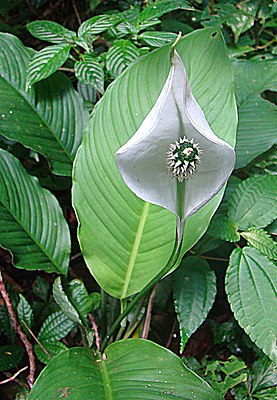Spathiphyllum wendlandii
aus Wikipedia, der freien Enzyklopädie
| Spathiphyllum wendlandii | ||||||||||||
|---|---|---|---|---|---|---|---|---|---|---|---|---|

Spathiphyllum wendlandii | ||||||||||||
| Systematik | ||||||||||||
| ||||||||||||
| Wissenschaftlicher Name | ||||||||||||
| Spathiphyllum wendlandii | ||||||||||||
| Schott |
Spathiphyllum wendlandii ist eine Pflanzenart aus der Familie der Aronstabgewächse (Araceae). Sie ist in Costa Rica und Panama heimisch.
Beschreibung
Die Laubblätter der Art sind verkehrt-lanzettlich oder lanzettlich länglich-rund bis breit oder schmal-elliptisch. Am Ansatz sind sie meist keilförmig zugespitzt. Die Blätter sind 38 bis 74 Zentimeter lang und 11 bis 28 Zentimeter breit.
Die Spatha ist schmal bis breit elliptisch, erreicht eine Länge von 16 bis 29 Zentimeter und von 5,5 bis 9,8 Zentimeter. Sie ist weiß, ebenso wie der Kolben.
Verbreitung und botanische Geschichte
Spathiphyllum wendlandii ist nur in Honduras, Costa Rica und Panama heimisch[1] und wächst dort in Nasswäldern. Die Art wurde 1858 von Heinrich Wilhelm Schott erstbeschrieben.
Weblinks
Commons: Spathiphyllum wendlandii – Sammlung von Bildern, Videos und Audiodateien
Literatur
- Anton Weber, Werner Huber, Anton Weissenhofer, Nelson Zamora, Georg Zimmermann: An Introductory Field Guide To The Flowering Plants Of The Golfo Dulce Rain Forests Costa Rica. In: Stapfia. Band 78, Linz 2001, S. 98, ISSN 0252-192X / ISBN 3854740727, zobodat.at [PDF]
Einzelnachweise
- ↑ Rafaël Govaerts (Hrsg.): Spathiphyllum - World Checklist of Selected Plant Families des Royal Botanic Gardens, Kew. Zuletzt eingesehen am 17. Juni 2018.